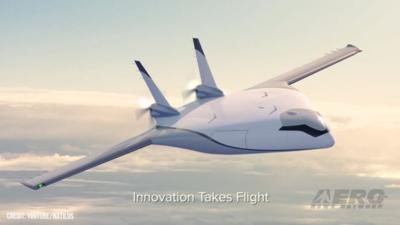Rise of the Blended Wing Body
JetZero’s clout was further bolstered by a 16 August announcement setting forth the U.S. Air Force had awarded the company $235-million to build an airliner-scale, piloted, Blended Wing Body technology demonstrator in partnership with Northrop-Grumman and Scaled Composites.

The funds will be distributed over a four-year period culminating, presumably, in a 2027 first-flight. The planned aircraft will be assembled at Scaled Composites’s Mojave, California facility and powered, ostensibly, by a pair of Pratt & Whitney PW100-series Geared Turbofan (GTF) engines.
Initial reports suggest the demonstrator’s completion will require additional capital—beyond the $235-million award from the U.S. Department of Defense Innovation Unit (DIU).
Though not ascribed, officially, to the USAF’s Next Generation Air-refueling System (NGAS) the JetZero demonstrator will likely inform the design of such.
The DIU’s initial solicitation to industry for a BWB demonstrator was made in July 2022. Additional details germane to the machine’s specifications and objectives were spelled-out in the Air Force’s Climate Action Plan.
As JetZero’s inchoate BWB aircraft stands to drastically reduce fuel-consumption and carbon-emissions, oversight of its development has been ascribed to the Air Force Operational Energy Office—a division of the service tasked with mitigating operational risk to the warfighter and optimizing the means by which the USAF utilizes fuel by developing and championing “energy-informed solutions.”
The Air Force stated in a press-release: “The effort aims to mature BWB technology and demonstrate its capabilities, giving the Department and commercial industry more options for future air platforms.”
The BWB demonstrator will depart radically from the tube-and-wing orthodoxy characteristic of legacy aircraft designs, comprising, instead, a modified flying-wing architecture expected to reduce drag by upwards of thirty-percent while improving lift.
The BWB epithet derives of the manner in which the wings and fuselages of such aircraft blend seamlessly together, leaving no discernable juncture between the two constructs. The distal wing-sections of BWB aircraft are characteristically of the swept, high-aspect-ratio persuasion.
The BWB concept is neither new nor novel. The USAF’s history is replete with examples of large-scale flying-wing contraptions the likes of Northrop’s 1946-vintage YB-35 and Boeing’s X-48, the testing of which commenced in 2007 and concluded in 2013. Northrop-Grumman’s B-2 Spirit and B-21 Raider bombers also embody the flying-wing ethos.
While announcing JetZero’s securing of the $235-million DIU developmental contract at an Air & Space Forces Association event, Air Force Secretary Frank Kendall remarked: “BWB aircraft have the potential to transform air operations for the Air Force and significantly reduce fuel demand, giving our warfighters the strategic advantage they need to win.”
The Air Force press-release echoed Kendall’s tenor, positing: “This [aircraft’s] increased efficiency will enable extended range, more loiter time, and increased payload delivery efficiencies; capabilities that are vital to mitigating logistics risks.”
The BWB concept is applicable, theoretically, to theater lift and air refueling platforms. Such aircraft account for sixty-percent of the USAF’s annual fuel-consumption.
Dubbed Z-5, JetZero’s BWB tanker concept has the potential to burn fifty-percent less fuel than extant tanker aircraft—so assert its designers. Moreover, JetZero has made clear its intention to vie for the NGAS contract.
USAF assistant secretary for energy, installations, and environment Dr. Ravi Chaudhary averred: “Today’s announcement marks another game-changing milestone for the Air Force in our efforts to maintain the advantage of airpower effectiveness against any future competitors.”
Notwithstanding the august company by which the company is staffed, JetZero’s BWB offering will likely be preceded in flight by a machine designed and built by Natilus, a San Diego aero-technology concern currently on-track to fly its BWB concept in 2024.
Founded in 2016 by former Piper lead aerodynamicist Aleksey Matyushev and aerospace engineer Anatoly Star, Natilus announced on 19 April 2023 that it had successfully completed multiple flights of a subscale prototype of the company’s planned regional cargo aircraft.
To date, stability has been among the key challenges of the BWB design; Natilus’s test flights, however, demonstrated the company’s BWB configuration is capable of flying in the absence of complex autopilot systems.

Natilus intends to offer three iterations of its remotely-piloted cargo aircraft: the Kona, a short-haul feeder UAV with a 3.8-metric-ton maximum payload; the Alisio, a medium/long-range UAV with a sixty-metric-ton maximum payload; and the Nordes, a long-range cargo UAV with a one-hundred-metric-ton payload.
To date, Natilus has logged north of $6.8-billion in order commitments and 460+ aircraft pre-orders from major airlines and supply-chain integrators the likes of Volatus Aerospace, Flexport, Astral, Aurora International, and Dymond.
On 26 January 2023, Nautilus announced that Ameriflight—the DFW-based cargo airline and largest FAA Part 135 cargo air-carrier—had signed a purchase agreement valued at $134-million for twenty of Natilus’s Kona feeder aircraft.
Natilus aircraft are designed to be remotely piloted by licensed UAV operators. Ergo, the company asserts its offerings can be operated at only forty-percent of the cost of comparably-sized, manned cargo aircraft.
Founded by Mark Page, former McDonnell Douglas program manager and co-creator of the Blended Wing Body (BWB) aeronautical concept; headed-up by Dr. John Vassberg, former Chief Aerodynamicist of Boeing’s Phantom Works; and advised, in part, by former Airbus CEO Barry Eccleston, former Learjet CEO Brian Barents, and Former Gulfstream president Bryan Moss, Long Beach, California-based JetZero is among the 21st Century’s more formidable aerospace startups.
 ANN's Daily Aero-Term (04.28.24): Airport Marking Aids
ANN's Daily Aero-Term (04.28.24): Airport Marking Aids Aero-News: Quote of the Day (04.28.24)
Aero-News: Quote of the Day (04.28.24) ANN's Daily Aero-Linx (04.28.24)
ANN's Daily Aero-Linx (04.28.24) Aero-News: Quote of the Day (04.29.24)
Aero-News: Quote of the Day (04.29.24) ANN's Daily Aero-Linx (04.29.24)
ANN's Daily Aero-Linx (04.29.24)




